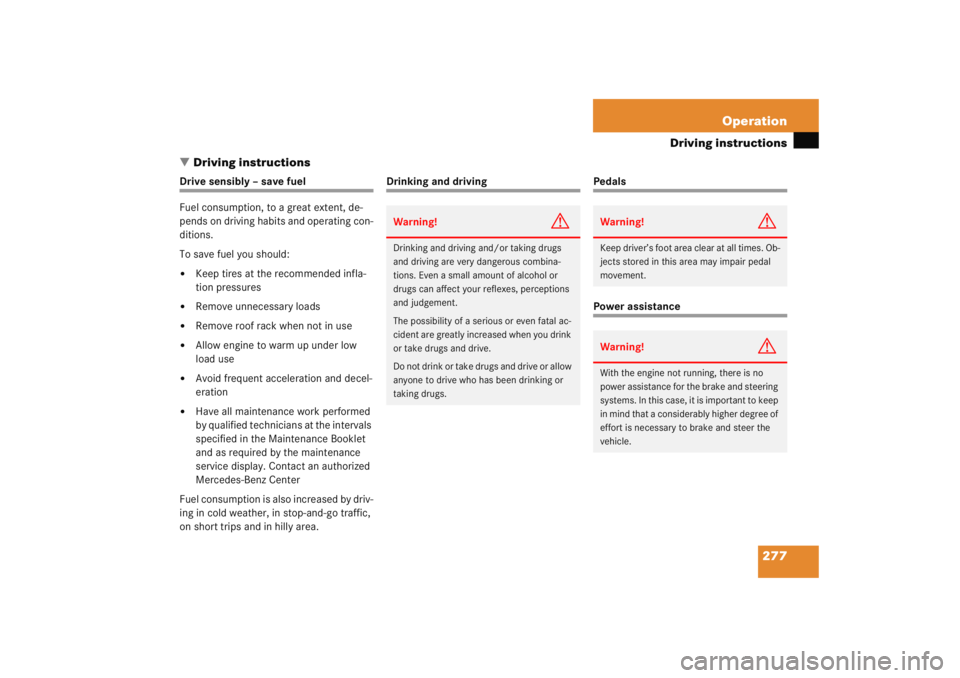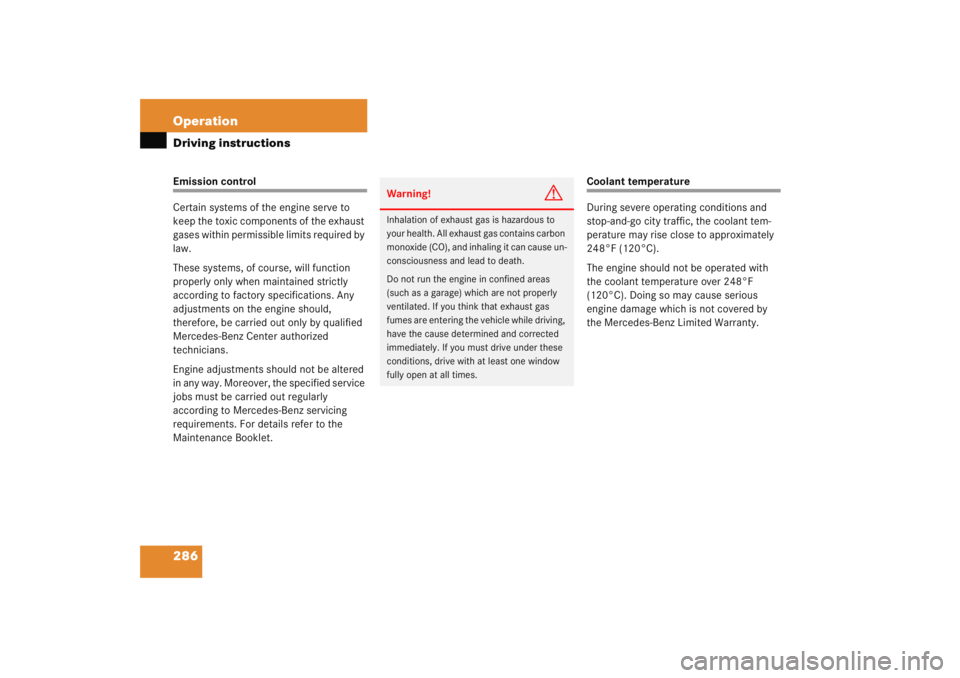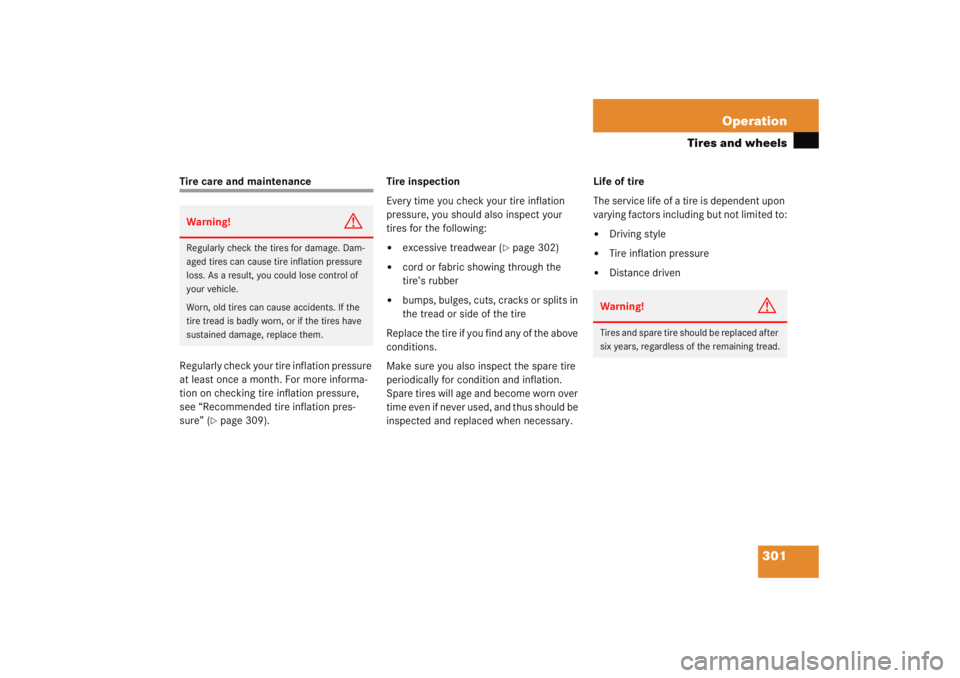Page 133 of 474

132 Controls in detailControl systemVehicle status message memory menu
Use the vehicle status message memory
menu to scan malfunction and warning
messages that may be stored in the sys-
tem. Such messages appear in the
multifunction display and are based on
conditions or system status the vehicle’s
system has recorded.
�
Press buttonè orÿ repeatedly
until the vehicle status message
memory appears in the multifunction
display. No vehicle status messages
If no conditions are recorded in memory,
the message in the multifunction display
is:
No message
Vehicle status messages have been
recorded
If conditions have occurred causing status
messages to be recorded, the number of
messages appears in the multifunction
display:
1 Number of messages
Warning!
G
Malfunction and warning messages are only
indicated for certain systems and are inten-
tionally not very detailed. The malfunction
and warning messages are simply a remind-
er with respect to the operation of certain
systems and do not replace the owner’s
and/or driver’s responsibility to maintain
the vehicle’s operating safety by having all
required maintenance and safety checks
performed on the vehicle and by bringing
the vehicle to an authorized Mercedes-Benz
Center to address the malfunction and
warning messages (
�page 347).
Page 276 of 474
275
Operation
The first 1000 miles (1500km)
Driving instructionsAt the gas station
Engine compartment Tires and wheelsWinter driving
MaintenanceVehicle care
Page 278 of 474

277
Operation
Driving instructions
� Driving instructions
Drive sensibly – save fuel
Fuel consumption, to a great extent, de-
pends on driving habits and operating con-
ditions.
To save fuel you should:�
Keep tires at the recommended infla-
tion pressures
�
Remove unnecessary loads
�
Remove roof rack when not in use
�
Allow engine to warm up under low
load use
�
Avoid frequent acceleration and decel-
eration
�
Have all maintenance work performed
by qualified technicians at the intervals
specified in the Maintenance Booklet
and as required by the maintenance
service display. Contact an authorized
Mercedes-Benz Center
Fuel consumption is also increased by driv-
ing in cold weather, in stop-and-go traffic,
on short trips and in hilly area.
Drinking and driving
PedalsPower assistance
Warning!
G
Drinking and driving and/or taking drugs
and driving are very dangerous combina-
tions. Even a small amount of alcohol or
drugs can affect your reflexes, perceptions
and judgement.
The possibility of a serious or even fatal ac-
cident are greatly increased when you drink
or take drugs and drive.
Do not drink or take drugs and drive or allow
anyone to drive who has been drinking or
taking drugs.
Warning!
G
Keep driver’s foot area clear at all times. Ob-
jects stored in this area may impair pedal
movement.Warning!
G
With the engine not running, there is no
power assistance for the brake and steering
systems. In this case, it is important to keep
in mind that a considerably higher degree of
effort is necessary to brake and steer the
vehicle.
Page 286 of 474

285
Operation
Driving instructions
Telephones and two-way radios
Radio transmitters, such as a portable tele-
phone or a citizens band unit should only
be used inside the vehicle if they are con-
nected to an antenna that is installed on
the outside of the vehicle.
Refer to the radio transmitter operation
instructions regarding use of an external
antenna.
Catalytic converter
Your Mercedes-Benz is equipped with
monolithic-type catalytic converters, an
important element in conjunction with the
oxygen sensors to achieve substantial
control of the pollutants in the exhaust
emissions. Keep your vehicle in proper
operating condition by following our
recommended maintenance instructions
as outlined in your Maintenance Booklet.
Warning!
G
Never operate radio transmitters equipped
with a built-in or attached antenna (i.e. with-
out being connected to an external antenna)
from inside the vehicle while the engine is
running. Doing so could lead to a malfunc-
tion of the vehicle’s electronic system, pos-
sibly resulting in an accident and/or
personal injury.
!To prevent damage to the catalytic con-
verters, use only premium unleaded
gasoline in this vehicle.
Any noticeable irregularities in engine
operation should be repaired promptly.
Otherwise, excessive unburned fuel
may reach the catalytic converter,
causing it to overheat and potentially
start a fire.
Warning!
G
As with any vehicle, do not idle, park or
operate this vehicle in areas where combus-
tible materials such as grass, hay or leaves
can come into contact with the hot exhaust
system, as these materials could be ignited
and cause a vehicle fire.
Page 287 of 474

286 OperationDriving instructionsEmission control
Certain systems of the engine serve to
keep the toxic components of the exhaust
gases within permissible limits required by
law.
These systems, of course, will function
properly only when maintained strictly
according to factory specifications. Any
adjustments on the engine should,
therefore, be carried out only by qualified
Mercedes-Benz Center authorized
technicians.
Engine adjustments should not be altered
in any way. Moreover, the specified service
jobs must be carried out regularly
according to Mercedes-Benz servicing
requirements. For details refer to the
Maintenance Booklet.
Coolant temperature
During severe operating conditions and
stop-and-go city traffic, the coolant tem-
perature may rise close to approximately
248°F (120°C).
The engine should not be operated with
the coolant temperature over 248°F
(120°C). Doing so may cause serious
engine damage which is not covered by
the Mercedes-Benz Limited Warranty.
Warning!
G
Inhalation of exhaust gas is hazardous to
your health. All exhaust gas contains carbon
monoxide (CO), and inhaling it can cause un-
consciousness and lead to death.
Do not run the engine in confined areas
(such as a garage) which are not properly
ventilated. If you think that exhaust gas
fumes are entering the vehicle while driving,
have the cause determined and corrected
immediately. If you must drive under these
conditions, drive with at least one window
fully open at all times.
Page 295 of 474

294 OperationEngine compartmentIf you see the message:Observe waiting time�
If engine is at operating temperature,
wait five minutes before repeating
check procedure.
�
If engine is not at operating tempera-
ture yet, wait 30 minutes before
repeating check procedure.
If you see the message:
Engine oil level
Not when engine on�
Turn off the engine.
�
If the engine is at operating tempera-
ture, wait five minutes before checking
oil.
�
If the engine is not at operating temper-
ature yet, you must wait 30 minutes
before checking oil. If there is excess engine oil with the engine
at normal operating temperature, the
following message will appear:
Engine oil level
Reduce oil level�
Have excess oil siphoned or drained
off. Contact an authorized
Mercedes-Benz Center.
For more information on messages in the
display concerning engine oil, see “Practi-
cal hints” (
�page 363). Adding engine oil
!Excess oil must be siphoned or drained
off. It could cause damage to the
engine and catalytic converter not
covered by the Mercedes-Benz Limited
Warranty.
!Only use approved engine oils and oil
filters required for vehicles with
Maintenance System (U.S. vehicles) or
FSS (Canada vehicles). For a listing of
approved engine oils and oil filters,
refer to the Factory Approved Service
Products pamphlet in your vehicle
literature portfolio, or contact an
authorized Mercedes-Benz Center.
Using engine oils and oil filters of spec-
ification other than those expressly
required for the Maintenance System
(U.S. vehicles) or FSS (Canada vehi-
cles), or changing of oil and oil filter at
change intervals longer than those
called for by the Maintenance System
(U.S. vehicles) or FSS (Canada vehi-
cles) will result in engine damage not
covered by the Mercedes-Benz Limited
Warranty.
Page 298 of 474

297
Operation
Engine compartment
The coolant expansion tank is located on
the passenger side of the engine compart-
ment.
1 Coolant expansion tank
2 Cap
�
Using a rag, turn the cap 2 slowly
approximately one half turn counter-
clockwise to release any excess
pressure.
�
Continue turning the cap counterclock-
wise and remove it.
The coolant level is correct if the level �
for cold coolant: reaches the black
top part of the reservoir
�
for warm coolant: is approximately
0.6 in (1.5 cm) higher
�
Add coolant as required.
�
Replace and tighten cap.
Battery
Your vehicle’s battery is located in the en-
gine compartment on the right hand side.
The battery should always be sufficiently
charged in order to achieve its rated ser-
vice life. Refer to Maintenance Booklet for
battery maintenance intervals.
If you use your vehicle mostly for
short-distance trips, you will need to have
the battery charge checked more
frequently.
When replacing the battery, always use
batteries approved by Mercedes-Benz.
If you do not intend to operate your vehicle
for an extended period of time, consult an
authorized Mercedes-Benz Center about
steps you need to observe.
Page 302 of 474

301
Operation
Tires and wheels
Tire care and maintenance
Regularly check your tire inflation pressure
at least once a month. For more informa-
tion on checking tire inflation pressure,
see “Recommended tire inflation pres-
sure” (
�page 309).
Tire inspection
Every time you check your tire inflation
pressure, you should also inspect your
tires for the following:
�
excessive treadwear (
�page 302)
�
cord or fabric showing through the
tire’s rubber
�
bumps, bulges, cuts, cracks or splits in
the tread or side of the tire
Replace the tire if you find any of the above
conditions.
Make sure you also inspect the spare tire
periodically for condition and inflation.
Spare tires will age and become worn over
time even if never used, and thus should be
inspected and replaced when necessary. Life of tire
The service life of a tire is dependent upon
varying factors including but not limited to:
�
Driving style
�
Tire inflation pressure
�
Distance driven
Warning!
G
Regularly check the tires for damage. Dam-
aged tires can cause tire inflation pressure
loss. As a result, you could lose control of
your vehicle.
Worn, old tires can cause accidents. If the
tire tread is badly worn, or if the tires have
sustained damage, replace them.
Warning!
G
Tires and spare tire should be replaced after
six years, regardless of the remaining tread.